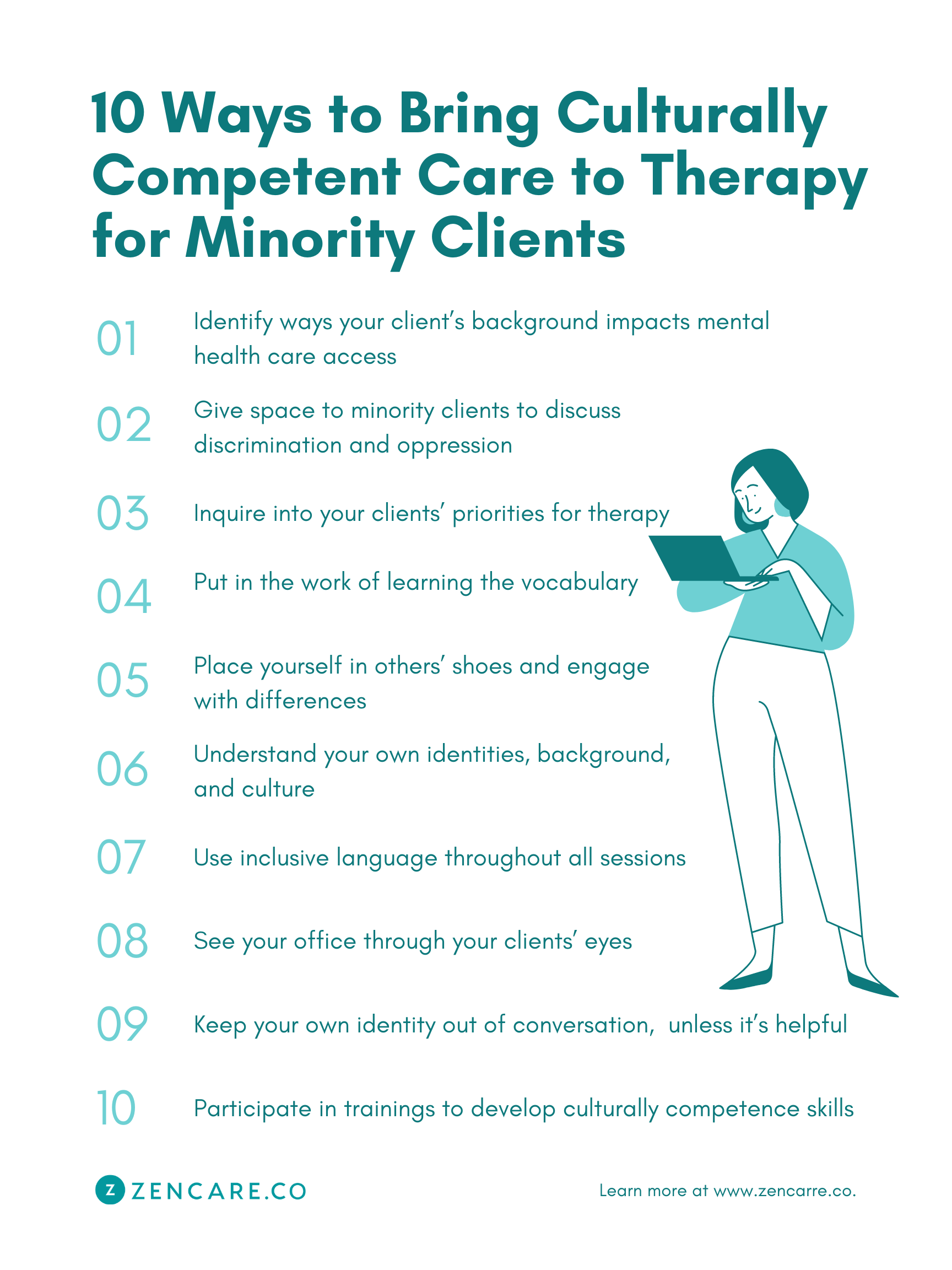Culturally competent care is the practice of intentionally serving the whole client. We often hear the therapy catchphrase, “meet the client where they’re at”; culturally competent care is about understanding where clients are from. It’s almost impossible to leave power, privilege, or identity out of therapy sessions, and recognizing and working within a client’s cultural background demonstrates acceptance and respect.
Therapists practice culturally competent care by acknowledging and learning more about clients’ unique backgrounds, and from there, offering services tailored towards each client’s needs – whether that means learning specific vocabulary, or recognizing the role that discrimination may play in the client’s mental health story. There are many ways to enhance your services to be more culturally competent across race, ethnicity, nationality, sexuality, gender, socio-economic status, ability, and other dimensions of identity– essentially, everywhere we come from!
Read below for 10 ways to intentionally value your clients’ cultural backgrounds and provide culturally competent care.
1. Identify ways that your client’s background impacts accessibility of mental health care
As a therapist, identifying the ways that culture and background affect a client can lead to better understanding resistance, readiness for change, openness, or trust in sessions.
In the United States (and especially in larger cities like New York, Los Angeles, Chicago), many individuals, couples, and families are encouraged and choose to seek therapy regularly. However, this isn’t the case universally: some cultures discourage therapy or may find it abnormal for an individual to participate in mental health treatment. Certain groups may feel less comfortable speaking openly about their ideas or emotions, which means that it’s important for therapists to understand the significance for minority clients to be in therapy in the first place.
For example, BIPOC folks might feel resistance to accessing health care and mental health care. Historically, healthcare professionals have caused direct emotional and physical harm to people of color, through misguided treatments or in the name of research. With this historical context, it makes sense that some BIPOC individuals forgo speaking with a provider at all – there may be an initial lack of trust, which means that if they do enter therapy, the therapist needs to work to build this trust upfront.
Another example comes from Chinese culture. While Chinese culture is broad (with many sub-cultures based on different geographies, ethnicities, and languages), stoicism can be a sign of strength. If a Chinese individual seeks help from a therapist, they may not disclose their sessions to loved ones. Therapists in this situation need to be particularly discrete in their communication, and acknowledge the valid reasons behind not involving others in treatment.
2. Give space to minority clients to discuss discrimination and oppression
In addition to identifying the ways in which clients’ cultural backgrounds impact their therapeutic experience, therapists need to be prepared to discuss how discrimination or oppression show up in minority clients’ lives. When therapists openly recognize that these experiences happen, they communicate to clients that they are seen, and that their struggles deserve empathy and kindness.
Some clients may take just a session or two to disclose stories about discrimination – others may take months or even years to describe the impact of these adverse experiences. As a therapist, it’s vital to feel comfortable engaging in discussions about the impact of racism, sexism, and other systems of oppression. By having validation and empathy ready at hand, therapists can support their clients processing through what happened and how it made them feel. If a client seems reluctant to bring up their identity in sessions, don't push, but do leave space for it.
3. Inquire into your clients’ priorities for therapy
Clients are the masters of their own therapy journeys, and every client has their own goals for being in therapy. These priorities may differ based on identity, and, specifically, minority identities.
Some clients will want to openly discuss how certain discriminatory experiences have affected them; others may not even realize that their panic attacks or low self-esteem have origins in their experiences as a cultural minority. Discrimination and oppression show up in mental health in different ways, so asking your clients to explicitly determine their own priorities not only gives them complete control over your conversations (something that might not happen frequently outside of therapy) but also gives you guidance on how to approach the relationship.
Facing discrimination makes many people feel anxious, depressed, disconnected, or disappointed. If your client brings up feelings like these, ask yourself if these might be symptoms resulting from oppression. If clients prioritize working through these feelings, bringing up the role of identity may be a helpful pathway towards healing.

4. Put in the work of learning the vocabulary
With all clients, it’s important to put in the preparation to understand and mirror their language. Educating yourself on concepts specific to a culture or background gives you a unique lens from which to understand your clients and make them feel seen.
When working with LGBTQ clients, make sure you are proficient in the vocabulary relevant to gender, sexuality, and identity. You may also want to practice using varied pronouns depending on your clients’ identities. (You can find a helpful guide in this article.)
With clients who come from different countries, learning about significant holidays, traditions, and practices may augment your understanding of your clients’ daily lives.
Learning about the different types of discrimination is also an intentional way to ensure that you’ll fully ready to speak about these topics when they come up in therapy. You might look up the difference between power, oppression, micro-aggressions, and more to have the vocabulary ready either to educate your client or empathize with them.
5. Place yourself in others’ shoes and engage with differences
As a therapist, placing yourself in other people’s shoes can be a great practice in empathy. By reading books, watching movies, or listening to podcasts that positively represent people of different backgrounds, you get a brief glimpse into lives that are dissimilar to your own.
Think of the practice of engaging with different cultures as a a way to find out how people may think, feel, live, or connect with others, and keep questions like these in mind:
- How is this different from my own life? How is it similar?
- What does a day in this person’s life look like and how does their culture impact this routine?
- How does this culture or background impact a person’s ability to express themselves?
- How does this culture or background view mental health?
Being intentional about mentalizing (considering how other people think or feel) gives you an opportunity to grow your connection to other people’s behaviors or opinions.
6. Dedicate yourself to understanding your own identities, background, and culture
To serve your minority clients, knowing exactly who you are – and how you show up to others – is a valuable part of building a strong therapeutic alliance. Knowing who you are and paying attention to how you come off to your clients may help you gain the clients’ trust.
Here are a few guiding questions to consider about your identity and how it impacts therapy:
- Where am I from? What is my family like?
- What are my values and why are they my values? How might other people view these values?
- What do I look like? How does my appearance affect my social interactions?
- How do I experience privilege and oppression? Are these experiences explicit to an outside person based on how I look or act?
With a better idea of how you show up in spaces, you can consider how your identity appears to each of your clients. Keep in mind that these identities may help or hinder a therapeutic alliance – and how you bring them to session matters.

7. Be intentional about using inclusive language throughout all therapy sessions
Clients tell therapists a lot – but not always everything. For myriad reasons, clients may keep information about themselves under wraps, which means that therapists need to be sure to use inclusive language throughout all sessions so as not to cause distress. This may come up in gender identity, religious beliefs, or hobbies and passions – so be sure to start neutral in opinion, especially as you get to know new clients.
Using correct pronouns for the client, their friends, and their family members shows that you’re comfortable and savvy when it comes to different identities. Until you hear your clients use pronouns to describe themselves or others, it may be helpful to use the gender neutral pronoun “they” (a good practice in mirroring language).
For clients who come from different countries, you may find yourself needing to say a word that is hard-to-pronounce in your native language, such as a city name or a person’s name. Ask permission to pause the session to learn the correct way to say the word. You might benefit from practicing the word or name outside of session too. It can be awkward and alienating for the client if you're repeatedly mispronouncing something that’s important to them.
8. See your office through your clients’ eyes
For both your physical office and your online “office” (that is, what a client can see in the background during video sessions), how the space looks matters to clients. Making your space as inclusive as possible may mean offering gender neutral bathrooms, disability accessibility, and neutral decor.
Take a few minutes to look around your room (both your waiting room and your therapy space). How would a person new to this environment view the space? Does the space feel inviting? Would it feel inviting to people of all backgrounds?
Redecorating with neutral accents is one way to make a space culturally competent. However, you might also consider decorating to make your inclusivity explicit, such as including “Safe Space” signs or the pride flag. (You can always download a free set of Safe Space posters here.)
Where you do therapy together matters. This is a powerful place, so be sure to send the most comfortable message possible to your clients.
9. Keep your own identity out of conversation – unless it’s helpful
Therapists have different comfort zones when it comes to self-disclosure. When working with minority clients, it may be tempting to relate to their identities as a way of building rapport (say, for example, when you share a minority identity). While you should be aware of the role your identity plays in the therapeutic relationship, the sessions are not about you. For this reason, keeping your identity out of the conversation as much as possible ensures that sessions remain client-centered.
However, disclosing an identity as a therapeutic tool may be helpful when working with some clients. Whether you share similar or differing identities, it’s vital to be intentional about this disclosure. Explain to your client why you disclosed and how it might benefit them to consider you in this way. Ask the client how it makes them feel about you or if anything changed after they learned about your identity.
10. Participate in trainings to grow your culturally competent care skills
Taking the nine steps above is a great way to think about providing culturally competent care. However, to take your practice a step further, find a training on cultural competence. To enhance your skills and learn new ways to work with minority clients, check out professional organizations’ offerings. You might find trainings like this from NAMI, NASW, APA, or other organizations across the country.
Providing culturally competent care demonstrates your dedication to inclusivity, which may be particularly attractive for prospective clients. It may also open the door for current clients to further express themselves or share their feelings with and about you, deepening your relationship and fostering progress in therapy.
